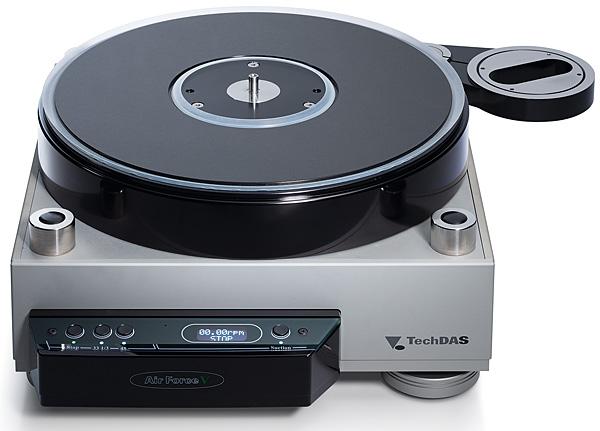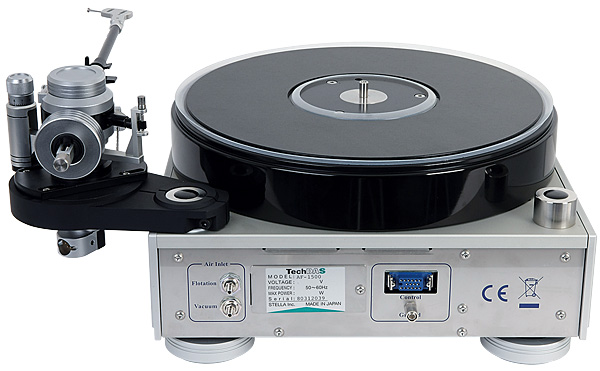TechDAS Air Force V Turntable

 Who knew that TechDAS could follow the remarkable Air Force III with an even less-expensive, air-bearing, vacuum hold-down turntable? We welcome the Air Force V
Who knew that TechDAS could follow the remarkable Air Force III with an even less-expensive, air-bearing, vacuum hold-down turntable? We welcome the Air Force V
Reason to celebrate: at £12,500, TechDAS's latest turntable – the Air Force V – costs one-tenth the price of the current Air Force One [HFN Jun '13]. Re-read that sentence. It means that the glory of owning one of the true upper-echelon turntables has been reduced by 90%. And you still get 90% of the performance.
This series of record decks has upped the ante for high-end turntables, offering air suspension, vacuum LP hold-down and an air-bearing with construction that recalls their spiritual ancestors: the classic Micro-Seikis of the 1970s and 1980s. With rapid dispatch, designer Hideaki Nishikawa, who created those legendary Micro-Seikis, has devised a full range of four models (there is no Air Force IV due to the Far Eastern notion that the number 4 is an ill omen) plus the high-end statement Air Force Zero due next year. With the Air Force V, however, the technology is now within the reach of exponentially more vinyl users.
Less Is More
For TechDAS ascending model numbers mean lower-prices, so following the Air Force III [HFN Sept '16] the visually-similar Air Force V exhibits only one obvious economic consideration at a glance – an in-board motor. But that doesn't account for a price nearly £17,000 lower. To get to the bottom of this seemingly inexplicable vinyl voodoo, I went straight to the source and Nishikawa-san kindly supplied this succinct clarification:
'The biggest difference is that the motor is in a separate unit in the Air Force III, whereas it is incorporated into the main chassis of the Air Force V. The main chassis is made of solid aluminium in the III and of machined aluminium plates assembled together in the V. Also, the III has a solid massive platter versus main and sub-platters in the V.'
To the price of £12,500 without tonearm, one can add a record clamp and up to three additional armboards. You might wonder why anyone would want four tonearms, but as a reviewer, I can only dream of the freedom it affords, especially for assessing arms or cartridges. Like the Air Force III, the V has a pillar at each corner that accepts the armboards that can be cut for any tonearm between 9in and 12in. Our review sample was fitted with the Graham Phantom, but I have also used the deck with the SAT and assorted SMEs.
As Nishikawa-san described above, there are material differences, and the Air Force V is less 'glamorous' than the III Premium, which is finished in gloss black. Unlike the stylised, curvaceous Air Force One, the Two [HFN May '15], III and V enjoy what is best described as the 'laboratory look' familiar to owners of Audio Research, Manley and EMT equipment: functional rather than fashionable. It emphatically states that this is a no-nonsense deck, a fact reiterated by its 30-page manual.

Set-up is not difficult, and the manual is comprehensive, but it does demand a sequence of procedures in order to avoid damage to the multi-part platter or the air pump/vacuum, which is housed in a separate, 350x175x270mm (whd) enclosure. TechDAS supplies all the necessary tools and hoses, including 'T'-shaped handles that facilitate the lifting of the 6.7kg anodised platter – essential as the fixed plate over which the air flows is made of smooth, polished glass.
Unlike the much larger One and Two, the V is remarkably compact, regardless of the number of arms deployed, with a near-square footprint of only 312x368mm. Obviously, one needs space around it to accommodate the tonearms that extend over the sides, so this won't quite fit into a 400mm-wide gap, but this remains a compact record deck like the III, which has a motor sitting separately to its side.
Like the III, the V has a control panel at the front that contains buttons for speed selection of 33.33 and 45rpm, plus 'stop', alongside a digital display that shows the precise speed and when it is locked. The pump also includes an auto shut-off facility after one hour, so you can leave the unit in standby unless you're going away for extended periods.
![]() This Sucks!
This Sucks!
Once you've experienced the benefits imparted by vacuum hold-down, it's hard to return to decks using a mere record clamp. The security, the flattening of mild warps – it's all good. With all LPs, including superior, heavy-duty pressings, the V mates them securely with the platter.
























































